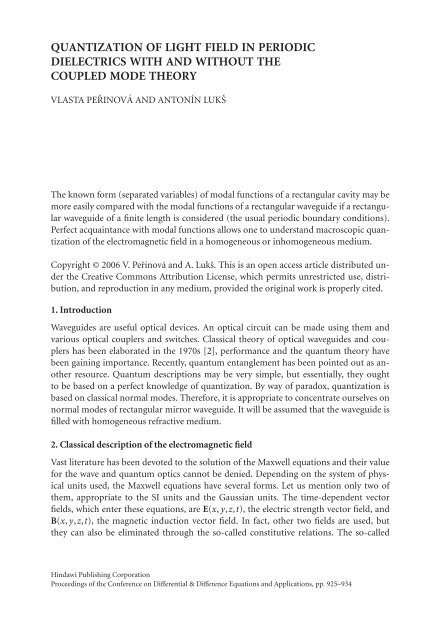DIFFERENtIAl & DIFFERENCE EqUAtIONS ANd APPlICAtIONS
DIFFERENtIAl & DIFFERENCE EqUAtIONS ANd APPlICAtIONS
DIFFERENtIAl & DIFFERENCE EqUAtIONS ANd APPlICAtIONS
You also want an ePaper? Increase the reach of your titles
YUMPU automatically turns print PDFs into web optimized ePapers that Google loves.
QUANTIZATION OF LIGHT FIELD IN PERIODIC<br />
DIELECTRICS WITH AND WITHOUT THE<br />
COUPLED MODE THEORY<br />
VLASTA PEŘINOVÁ AND ANTONÍN LUKŠ<br />
The known form (separated variables) of modal functions of a rectangular cavity may be<br />
more easily compared with the modal functions of a rectangular waveguide if a rectangular<br />
waveguide of a finite length is considered (the usual periodic boundary conditions).<br />
Perfect acquaintance with modal functions allows one to understand macroscopic quantization<br />
of the electromagnetic field in a homogeneous or inhomogeneous medium.<br />
Copyright © 2006 V. PeřinováandA.Lukš. This is an open access article distributed under<br />
the Creative Commons Attribution License, which permits unrestricted use, distribution,<br />
and reproduction in any medium, provided the original work is properly cited.<br />
1. Introduction<br />
Waveguides are useful optical devices. An optical circuit can be made using them and<br />
various optical couplers and switches. Classical theory of optical waveguides and couplers<br />
has been elaborated in the 1970s [2], performance and the quantum theory have<br />
been gaining importance. Recently, quantum entanglement has been pointed out as another<br />
resource. Quantum descriptions may be very simple, but essentially, they ought<br />
to be based on a perfect knowledge of quantization. By way of paradox, quantization is<br />
based on classical normal modes. Therefore, it is appropriate to concentrate ourselves on<br />
normal modes of rectangular mirror waveguide. It will be assumed that the waveguide is<br />
filled with homogeneous refractive medium.<br />
2. Classical description of the electromagnetic field<br />
Vast literature has been devoted to the solution of the Maxwell equations and their value<br />
for the wave and quantum optics cannot be denied. Depending on the system of physical<br />
units used, the Maxwell equations have several forms. Let us mention only two of<br />
them, appropriate to the SI units and the Gaussian units. The time-dependent vector<br />
fields, which enter these equations, are E(x, y,z,t), the electric strength vector field, and<br />
B(x, y,z,t), the magnetic induction vector field. In fact, other two fields are used, but<br />
they can also be eliminated through the so-called constitutive relations. The so-called<br />
Hindawi Publishing Corporation<br />
Proceedings of the Conference on Differential & Difference Equations and Applications, pp. 925–934

















